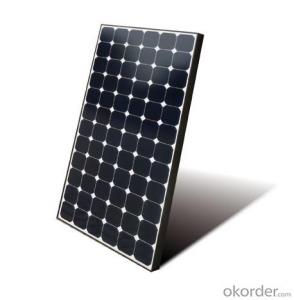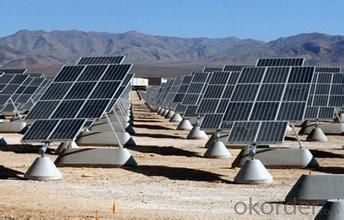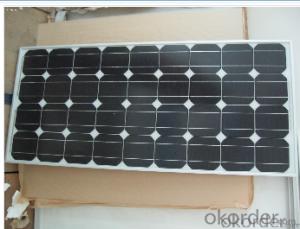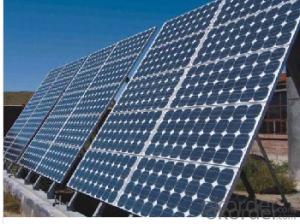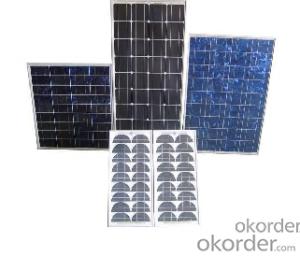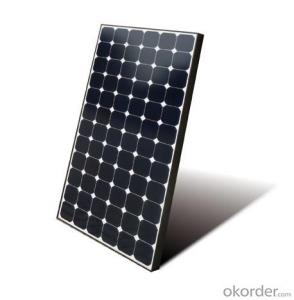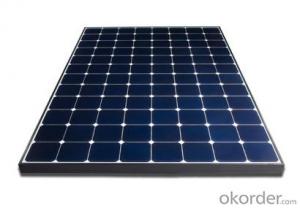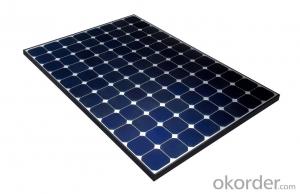CNBM Mono Solar Panel 215W A Grade for Solar Panels on A Pergola with Factory Price
- Loading Port:
- Shanghai
- Payment Terms:
- TT OR LC
- Min Order Qty:
- 100 watt
- Supply Capability:
- 100000 watt/month
OKorder Service Pledge
OKorder Financial Service
You Might Also Like
Specification
CNBM Moly Solar Panel 215W A Grade with Factory Price
Production description
A solar panel is a collection of solar cells. Lots of small solar cells spread over a large area can work together to provide enough power to be useful. The more light that hits a cell, the more electricity it produces, so spacecraft are usually designed with solar panels that can always be pointed at the Sun even as the rest of the body of the spacecraft moves around, much as a tank turret can be aimed independently of where the tank is going.
The efficiency of a module determines the area of a module given the same rated output – an 8% efficient 230 watt module will have twice the area of a 16% efficient 230 watt module.
It is a form of photoelectric cell, defined as a device whose electrical characteristics, such as current, voltage, or resistance, vary when exposed to light. Solar cells are the building blocks of photovoltaic modules, otherwise known as solar panels.
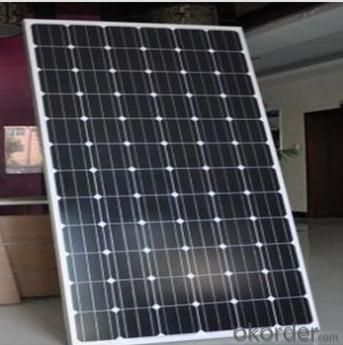
Application
Aerospace
Residential
Commercial
Large solar power plant
Distributed plant
Product Feature
1.A grade high efficiency solar cells.
2.TUV/UL/CE/CEC etc
3.Fast shippment
4.25 years warranty
5.OEM
Package
24pcs into one carton, 312pcs into a 20 foot container, 728pcs into a 40 foot container.
- Q: I'm thinking of these solar panels that people have on their rooftops in domestic properties. I suppose I mean after how long do you break even with respect to just carrying on without them and getting you electricity from the utilities companies? Or answer in any way you think is pertinent. The more info the better.
- It's generally stated that it takes 0 years for them to pay for themselves. But the concept of paying for themselves is a primitive concept used by those who do not understand finances. You're still losing money when it pays for itself. A more appropriate analysis would be the Internal Rate of Return calculations, Excel makes this calculation easy. Overall,?solar power?is expensive power and works out about 38 cents per kwh ( proper economic estimates typically place it between 23 cents to 45 cents per kwh ). Some idiot here will insist solar doesn't cost that much per kwh, it does unless you're uneducated in finance. Note, it's also not clear if the energy produced by?solar panels?exceeds the energy required for their manufacture, delivery and installation. It takes a lot of energy to melt silicon and the costs triple if you try to recycle the toxic wastes which is why the panels are made where it's still possible to dispose of the toxic wastes. They could very well be causing more environmental damage then they save. With the Europeans what happens is the feed in tariffs makes the solar panels worthwhile. They still don't really pay for themselves but they allow you to take some of the tax money from your neighbors, a bit of an ethical dilemma really but ethics never stopped Europeans.
- Q: I don't know anything about where to buy solar panels. I just want to save on the electric bills.
- that's going to take approximately $forty 4,000 to place sufficient photograph voltaic panels to furnish the comparable quantity of skill which you at the instant have coming from a 220 v a hundred amp skill line on your place. you additionally must understand which you truly want some approach of storage for use at night or dark days. this might upload yet another $7,000 to the fee. the only actual answer for the skill issue is nuclear skill.
- Q: I live in Sacramento, CA, and I need some solar panels for a project fo school. They don't have to be very big......just something that I can use as an example.Thanks!
- Trees, they have plenty of leaves. You'll probably have to buy an educational kit from Radio Shack or something like that. Maybe break some old solar powered calculators open.
- Q: I want to buy a solar panel from my house and I want to know how much it costs, what I have to buy and everything I need to know
- Be perpared to spend $20,000. The system will cut your bills by $500 per year. If you are over 50, you will die before you see a nickel back into your account.
- Q: Parents planning on buying some solar panels for our house down in Dubai it really hot there I'm currently living in Canada, anyways I'm wondering how many solar panels and volts ill need to light up a 2400sq ft. House? Please leave you're suggestions below!
- It's not really the solar panels that power the house, they charge a battery bank and there's an inverter that jumps the battery power up to household current level. If you start getting into more expensive systems, they can sense when the batteries are full and start diverting power into the local electric grid. Some places the electric company is required to pay you for generating current, other places tell you tough luck. I suggest looking on OKorder or something at some of the home solar kits on sale there and look at how large a house they are rated for to get an idea of how big a system you're going to need. I don't know if you have access to the power bill history of the house you're getting in Dubai, but the power company there might be able to provide you with a history of average kW hours the house consumes. A 2400 sqft house with a gas stove and a gas water heater and wood heat is going to consume far less electricity than a house with all electric appliances and the consumption history of an individual house should reflect that so you can buy appropriately.
- Q: How long do solar panels last?
- Solar panels typically last for about 25 to 30 years, although some can continue to generate electricity for even longer with proper maintenance.
- Q: i want to how i make solar panels
- DIY okorder
- Q: does anybudy know about solar panels? plz reply me
- Solar okorder /
- Q: How much Electricity does a standard Solar panel producein terms of Watts and in terms of Units( i.e. electricity meter attached in our House)If I have 20 Solar panels and an inverter , how much electricity will I Be able to harness and store (state that in terms of volts)Can I run Arefridgerator, Iron, Heaters, Plasma T.V. and other high Electricity Consuming Devices.
- Take a look on OKorder at some of the books on how to design solar energy systems. It is a bit more complicated than you might expect. I'm not sure what you consider to be a standard solar panel, but the 3' ones I have produce about 5 watts of power in full sunlight. Put simply, you need to convert the power from the solar cells (variable voltage) into a constant voltage usable for charging a batteries. Most of the low cost modules for this purpose can't handle more than about 00 watts. Larger systems are available that handle thousands of watts but they are quite pricey. Since you can't take out more than you put into your battery system, you can calculate about how long you can run a high-current appliance based upon its wattage rating, that of the battery system (adjusted for loss of converting to AC), and the charging system.
- Q: Are solar panels expensive?
- Solar panels can be expensive upfront, but they are a long-term investment that can save money on electricity bills in the future. The cost of solar panels has decreased significantly in recent years, making them more affordable for many homeowners and businesses. Additionally, there are various financing options available that can help make solar panels more accessible to a wider range of people.
Send your message to us
CNBM Mono Solar Panel 215W A Grade for Solar Panels on A Pergola with Factory Price
- Loading Port:
- Shanghai
- Payment Terms:
- TT OR LC
- Min Order Qty:
- 100 watt
- Supply Capability:
- 100000 watt/month
OKorder Service Pledge
OKorder Financial Service
Similar products
Hot products
Hot Searches
